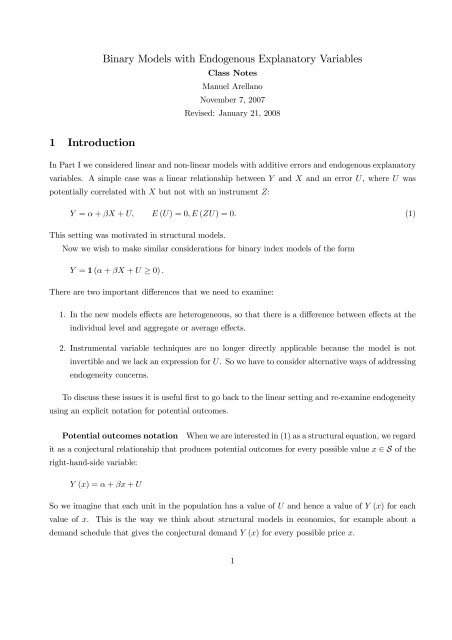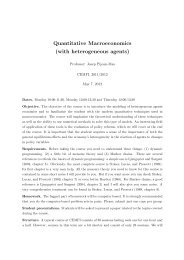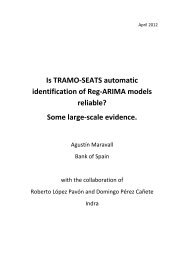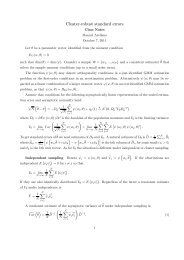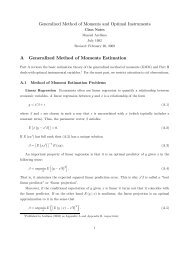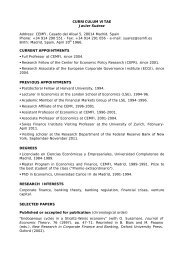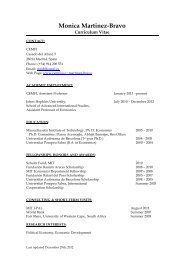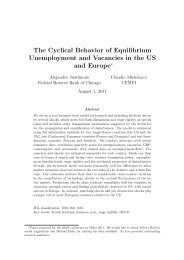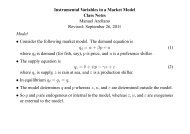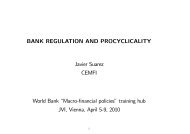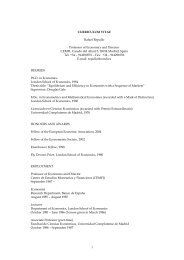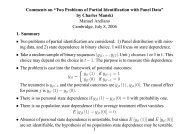Binary Models with Endogenous Explanatory Variables 1 ... - Cemfi
Binary Models with Endogenous Explanatory Variables 1 ... - Cemfi
Binary Models with Endogenous Explanatory Variables 1 ... - Cemfi
Create successful ePaper yourself
Turn your PDF publications into a flip-book with our unique Google optimized e-Paper software.
1 Introduction<br />
<strong>Binary</strong> <strong>Models</strong> <strong>with</strong> <strong>Endogenous</strong> <strong>Explanatory</strong> <strong>Variables</strong><br />
Class Notes<br />
Manuel Arellano<br />
November 7, 2007<br />
Revised: January 21, 2008<br />
In Part I we considered linear and non-linear models <strong>with</strong> additive errors and endogenous explanatory<br />
variables. A simple case was a linear relationship between Y and X and an error U, whereUwas potentially correlated <strong>with</strong> X but not <strong>with</strong> an instrument Z:<br />
Y = α + βX + U, E (U) =0,E(ZU)=0. (1)<br />
This setting was motivated in structural models.<br />
Now we wish to make similar considerations for binary index models of the form<br />
Y = 1 (α + βX + U ≥ 0) .<br />
There are two important differences that we need to examine:<br />
1. In the new models effects are heterogeneous, so that there is a difference between effects at the<br />
individual level and aggregate or average effects.<br />
2. Instrumental variable techniques are no longer directly applicable because the model is not<br />
invertible and we lack an expression for U. So we have to consider alternative ways of addressing<br />
endogeneity concerns.<br />
To discuss these issues it is useful first to go back to the linear setting and re-examine endogeneity<br />
using an explicit notation for potential outcomes.<br />
Potential outcomes notation When we are interested in (1) as a structural equation, we regard<br />
it as a conjectural relationship that produces potential outcomes for every possible value x ∈ S of the<br />
right-hand-side variable:<br />
Y (x) =α + βx + U<br />
So we imagine that each unit in the population has a value of U and hence a value of Y (x) for each<br />
value of x. This is the way we think about structural models in economics, for example about a<br />
demand schedule that gives the conjectural demand Y (x) for every possible price x.<br />
1
For each unit we only observe the actual value X that occurs in the distribution of the data, so<br />
that Y = Y (X). 1<br />
If the assignment of values of X to units in the population is such that X and U are uncorrelated,<br />
β coincides <strong>with</strong> the regression coefficient of Y on X. If the assignment of values of Z (a predictor of<br />
X) to units in the population is such that Z and U are uncorrelated, β coincides <strong>with</strong> the IV coefficient<br />
of Y on X using Z as instrument.<br />
Consider two individuals in the population <strong>with</strong> errors U and U † . Their potential outcomes will<br />
differ:<br />
Y (x) = α + βx + U<br />
Y (x) † = α + βx + U †<br />
but the effect of a change from x to x 0 will be the same for all individuals:<br />
Y ¡ x 0¢ − Y (x) =β ¡ x 0 − x ¢ .<br />
In this sense we say that in models <strong>with</strong> additive errors the effects are homogeneous across units. We<br />
nowturntoconsiderthesituationinbinarymodels.<br />
Heterogeneous individual effects and aggregate effects Potential outcomes in the binary<br />
model are given by<br />
Y (x) =1 (α + βx + U ≥ 0) .<br />
The effect of a change from x to x 0 for an individual <strong>with</strong> error U is:<br />
Y ¡ x 0¢ − Y (x) =1 ¡ α + βx 0 + U ≥ 0 ¢ − 1 (α + βx + U ≥ 0) .<br />
Suppose for the sake of the argument that β > 0 and x 0 >x. The possibilities are<br />
value of U Y (x) Y (x 0 ) Y (x 0 ) − Y (x)<br />
−U ≤ α + βx 1 1 0<br />
−U >α + βx0 0 0 0<br />
α + βx
In these circumstances it is natural to consider an average effect:<br />
£ ¡ 0<br />
Y x ¢ − Y (x) ¤ =<br />
=<br />
£ ¡ ¢¤ 0<br />
EU 1 α + βx + U ≥ 0 − EU [1 (α + βx + U ≥ 0)]<br />
Pr ¡ −U ≤ α + βx 0¢ − Pr (−U ≤ α + βx) =Pr ¡ α + βx
2 The normal endogenous explanatory variable probit model<br />
The model is<br />
Y = 1 (α + βX + U ≥ 0)<br />
X = π 0 Z + σvV<br />
à ! " à !#<br />
U<br />
1 ρ<br />
| Z ∼ N 0,<br />
.<br />
V<br />
ρ 1<br />
In this model X is an endogenous explanatory variable as long as ρ 6= 0. X is exogenous if ρ =0.<br />
Joint normality of U and V implies that the conditional distribution of U given V is also normal<br />
as follows:<br />
U | V,Z ∼ N ¡ ρV,1 − ρ 2¢<br />
or<br />
Therefore,<br />
à !<br />
Pr (U ≤ r | V,Z) =Φ<br />
r − ρV<br />
p<br />
1 − ρ2 .<br />
Pr (Y =1| X, Z) =Pr(α + βX + U ≥ 0 | V,Z) =Φ<br />
Ã<br />
!<br />
α + βX + ρV<br />
p .<br />
1 − ρ2 Moreover, the density of X | Z is just the normal linear regression density.<br />
Thus, the joint probability distribution of Y and X given Z = z is<br />
or<br />
f (y, x | z) =f (y | x, z) f (x | z)<br />
Ã<br />
!<br />
" Ã<br />
ln f (y, x | z) ∝ y ln Φ<br />
α + βx + ρv<br />
p<br />
1 − ρ2 +(1−y)ln 1 − Φ<br />
!#<br />
α + βx + ρv<br />
p −<br />
1 − ρ2 1<br />
2 ln σ2v − 1<br />
2 v2<br />
where v =(x− π0z) /σv.<br />
Therefore, the log likelihood of a random sample of N observations conditioned on the z variables<br />
is:<br />
L ¡ α, β, ρ, π, σ 2 ¢<br />
NX<br />
( Ã<br />
!<br />
" Ã<br />
!#)<br />
α + βxi + ρvi<br />
α + βxi + ρvi<br />
v = yi ln Φ p +(1−yi)ln 1 − Φ p<br />
1 − ρ2 1 − ρ2 i=1<br />
+<br />
NX<br />
i=1<br />
µ<br />
− 1<br />
2 ln σ2v − 1<br />
2 v2 <br />
i .<br />
Note that under exogeneity (ρ =0) this log likelihood function boils down to the sum of the<br />
ordinary probit and normal OLS log-likelihood functions:<br />
L ¡ α, β, 0, π, σ 2¢ ¡ ¢ 2<br />
v = Lprobit (α, β)+LOLS π, σv .<br />
4
3 The control function approach<br />
3.1 Two-step estimation of the normal model<br />
We can consider a two-step method:<br />
• Step 1: Obtain OLS estimates (bπ, bσv) of the first stage equation and form the standardized<br />
residuals bvi = ¡ xi − bπ 0 ¢<br />
zi /bσv, i =1, ..., N.<br />
• Step 2: Do an ordinary probit of y on constant, x, andbv to obtain consistent estimates of<br />
¡ α † , β † , ρ † ¢ where<br />
³<br />
α † , β † , ρ †´<br />
= ¡ 1 − ρ 2¢ −1/2 (α, β, ρ) .<br />
Since there is a one-to-one mapping between the two, the original<br />
³<br />
parameters can be recovered<br />
undoing the reparameterization. However, the fitted probabilities Φ bα † + b β † xi + bρ † ´<br />
bvi are in fact<br />
directly useful to get average derivative effects (see below).<br />
In general, two-step estimators are asymptotically inefficient relative to maximum likelihood estimation,<br />
but they may be computationally convenient.<br />
Ordinary probit standard errors calculated from the second step are inconsistent because estimated<br />
residuals are treated as if they were observations of the true first-stage errors. To get consistent<br />
standard errors, we need to take into account the additional uncertainty that results from using<br />
(bπ, bσv) as opposed to the truth (see the appendix).<br />
Comparison <strong>with</strong> probit using fitted values Note that<br />
Y = 1 (α + βX + U ≥ 0) = 1 ¡ α + β ¡ π 0 Z ¢ + ε ≥ 0 ¢<br />
where ε = U + βσvV is ε | Z ∼ N ¡ 0, σ2 ¢<br />
ε <strong>with</strong> σ2 ε =1+β 2 σ2 v +2βσvρ.<br />
If we run a probit of y on constant and bx = bπ 0 z we get consistent estimates of α = α/σε and<br />
β = β/σε. Note that from estimates of α, β, andσvwe cannot back up estimates of α and β due<br />
to not knowing ρ. We cannot get average derivative effects either. So estimation of parameters of<br />
interest from this method (other than relative effects) is problematic.<br />
3.2 The linear case: 2SLS as a control function estimator<br />
The 2SLS estimator for the linear IV model is bθ =<br />
³<br />
bX 0 ´ −1<br />
bX bX 0y where bX = Z bΠ 0 and bΠ =<br />
X0Z (Z0Z) −1 . The matrix of first-stage residuals is bV = X − Z bΠ 0 . Typically, X and Z will have<br />
some columns in common. For those variables, the columns of bV will be identically zero. Let us call<br />
bV1 the subset of non-zero columns of bV (those corresponding to endogenous explanatory variables).<br />
5
It can be shown that 2SLS coincides <strong>with</strong> the estimated θ in the OLS regression y = Xθ + bV1γ + ξ<br />
(see appendix). Therefore, linear 2SLS can be regarded as a control function method.<br />
In the binary situation we obtained a similar estimator from a probit regression of y on X and<br />
first-stage residuals. An important difference between the two settings is that 2SLS is robust to<br />
misspecification of the first stage model whereas two-step probit is not. Examples of misspecifications<br />
occur if E (X | Z) is nonlinear, if Var(X | Z) is non-constant (heteroskedastic), or if X | Z is nonnormal.<br />
Another difference is that in the linear case the control-function approach and the fitted-value<br />
approach lead to the same estimator (2SLS) whereas this is not true for probit.<br />
3.3 A semiparametric generalization<br />
Consider the model<br />
Y = 1 (α + βX + U ≥ 0)<br />
X = π 0 Z + σvV<br />
and assume that<br />
U | X, V ∼ U | V.<br />
In the previous parametric model we additionally assumed that U | V was N ¡ ρV,1 − ρ2¢ and V<br />
was N (0, 1). The semiparametric generalization consists in leaving the distributions of U | V and V<br />
unspecified.<br />
In this way<br />
Thus<br />
Pr (Y =1| X, V )=Pr(−U ≤ α + βX | X, V )=Pr(−U ≤ α + βX | V )<br />
E (Y | X, V )=F (α + βX, V )<br />
where F (., V ) is the conditional cdf of −U given V . The function F (., V ) can be estimated nonparametrically<br />
using estimated first-stage residuals. This is a bivariate-index generalization of the<br />
semiparametric approaches to estimating single-index models <strong>with</strong> exogenous variables (cf. Blundell<br />
and Powell, 2003).<br />
6
3.3.1 Constructing policy parameters<br />
To construct a policy parameter we need p (x) =Pr(−U≤ α + βx). Notethat<br />
Z<br />
Pr (−U ≤ α + βx) = Pr (−U ≤ α + βx | v) dFv ≡ EV [F (α + βx, V )] .<br />
In the normal model<br />
Pr (−U ≤ α + βx) =Φ (α + βx)<br />
But this means that<br />
" Ã<br />
!#<br />
α + βx + ρV<br />
Φ (α + βx) =EV Φ p ≡ EV<br />
1 − ρ2 h ³<br />
Φ α † + β † x + ρ † ´i<br />
V . (2)<br />
³<br />
A simple consistent estimate of Φ (α + βx) is Φ bα + b ´<br />
βx ,wherebαand b β are consistent estimates.<br />
For example, using that 1 − ρ2 =1/ ¡ 1+ρ †2¢ ,wemayuse<br />
³<br />
bα, b ´ ³<br />
β = 1+bρ †2´ −1/2 ³<br />
bα † , b β †´<br />
³<br />
where bα † , b β † , bρ †´<br />
are two-step control function estimates.<br />
Alternatively, using expression (2) a consistent estimate of Φ (α + βx) in the normal model can be<br />
obtained as<br />
bp (x) = 1<br />
N<br />
NX<br />
i=1<br />
³<br />
Φ bα † + b β † x + bρ † ´<br />
bvi .<br />
In the semiparametric model this result generalizes to<br />
ep (x) = 1<br />
N<br />
NX<br />
bF<br />
i=1<br />
³<br />
eα + e ´<br />
βx, bvi<br />
³<br />
where eα, e ´<br />
β are semiparametric control function estimates and bF (., .) is a non-parametric estimate<br />
of the conditional cdf of −U given V .<br />
7
4 The endogenous dummy explanatory variable probit model<br />
The model is<br />
Y = 1 (α + βX + U ≥ 0)<br />
X = 1 ¡ π 0 Z + V ≥ 0 ¢<br />
Ã<br />
U<br />
V<br />
! " Ã<br />
1<br />
| Z ∼ N 0,<br />
ρ<br />
!#<br />
ρ<br />
.<br />
1<br />
In this model X is an endogenous explanatory variable as long as ρ 6= 0. X is exogenous if ρ =0.<br />
Let us introduce a notation for standard normal bivariate probabilities: Φ2 (r, s; ρ) =Pr(U≤r, V ≤ s).<br />
The joint probability distribution of Y and X given Z consists of four terms:<br />
p00 =Pr(Y =0,X =0)=Pr(α + βX + U
Local average treatment effects (LATE) Considerthecasewhere<br />
X = 1 (π0 + π1Z + V ≥ 0)<br />
and Z is a scalar 0—1 instrument, so that there are only two potential values of X:<br />
X (1) = 1 (π0 + π1 + V ≥ 0)<br />
X (0) = 1 (π0 + V ≥ 0) .<br />
Suppose <strong>with</strong>out lack of generality that π1<br />
depending on an individual’s value of V :<br />
≥ 0. Then we can distinguish three subpopulations<br />
• Never-takers: Units <strong>with</strong> V < −π0 − π1. They have X (1) = 0 and X (0) = 0. Their mass is<br />
Φ (−π0 − π1) =1− Φ (π0 + π1).<br />
• Compliers: Units <strong>with</strong> V ≥−π0 − π1 but V
The nice thing about θLAT E is that it is identified from the Wald formula in the absence of joint<br />
normality. In fact, it does not even require the index model assumption for Y (1) and Y (0). Sowedo<br />
not need monotonicity in the relationship between Y and X. The relevance of θLAT E partly depends<br />
on how large the probability of compliers is, and partly on its policy relevance.<br />
We have<br />
θAT E = θLAT E Pr (compliers)+E [Y (1) − Y (0) | never-takers]Pr(never-takers)<br />
+E [Y (1) − Y (0) | always-takers]Pr(always-takers) .<br />
There is a connection <strong>with</strong> fixed-effects identification in binary-choice panel data models.<br />
Two related references are J. Angrist (2001, JBES, 19, 2—16) on LDV models, and Ed Vytlacil on<br />
the identification content of enforcing the index model assumption on Y (1) and Y (0).<br />
References<br />
[1] Blundell, R. and J. L. Powell (2003): “Endogeneity in Nonparametric and Semiparametric Regression<br />
<strong>Models</strong>”. In: M. Dewatripont, L. P. Hansen, and S. J. Turnovsky (eds.), Advances in<br />
Economics and Econometrics, Eighth World Congress, vol. II, Cambridge University Press.<br />
[2] Imbens, G. W. and J. Angrist (1994): “Identification and Estimation of Local Average Treatment<br />
Effects”, Econometrica, 62, 467-475.<br />
[3] Vytlacil, E. (2002): “Independence, Monotonicity, and Latent Index <strong>Models</strong>: An Equivalence<br />
Result” Econometrica, 70, 331-341.<br />
10
A 2SLS as a control function estimator<br />
The 2SLS estimator for the single equation model<br />
is given by<br />
yi = x 0 iθ + ui<br />
E (ziui) =0<br />
b θ = ¡ X 0 MX ¢ −1 X 0 My =<br />
³<br />
bX 0 ´ −1<br />
bX bX 0 y<br />
where X is N × k, Z is N × r, y is N × 1, andM = Z (Z 0 Z) −1 Z 0 . Moreover, the fitted values are<br />
bX = Z bΠ 0 where bΠ = X 0 Z (Z 0 Z) −1 , and the corresponding N × k matrix of first-stage residuals:<br />
bV = X − Z bΠ 0 =(IN − M) X ≡ QX.<br />
Typically, X and Z will have some columns in common (e.g. a constant term). For those variables,<br />
the corresponding columns of bV will be identically zero. That is, letting X =(X1,X2) and Z =<br />
(Z1,X2),<br />
bV = Q (X1,X2) =<br />
³ ´<br />
bV1, 0<br />
where bV1 = QX1 is the subset of non-zero columns of bV (those corresponding to endogenous explanatory<br />
variables).<br />
Now consider the coefficients of X in the OLS regression of y on X and bV1. Using the formulae<br />
for partitioned regression, these are given by<br />
e θ =<br />
µ<br />
X 0<br />
∙ ³<br />
IN − bV1 bV 0<br />
1 bV1<br />
´ −1<br />
bV 0<br />
¸ −1<br />
1 X X 0<br />
∙ ³<br />
IN − bV1 bV 0<br />
1 bV1<br />
´ −1<br />
bV 0<br />
1<br />
Clearly, e θ = b θ since<br />
e θ =<br />
³ h ¡ ¢ 0 0 −1 0<br />
X IN − QX1 X1QX1 X1Q i<br />
¸<br />
y.<br />
´ −1 h ¡ ¢ i<br />
0 0 −1 0<br />
X X IN − QX1 X1QX1 X1Q y<br />
= ¡ X 0 X − X 0 QX ¢ −1 ¡ X 0 y − X 0 Qy ¢ = ¡ X 0 MX ¢ −1 X 0 My.<br />
Note that, due to QX2 =0,wehave<br />
X 0 Ã !<br />
¡ ¢ 0 −1 0 X0 1QX1 0<br />
QX1 X1QX1 X1QX =<br />
= X<br />
0 0<br />
0 QX.<br />
Theconclusionisthat2SLSestimatescanbeobtainedfromtheOLSregressionofyon X and bV1.<br />
Therefore, linear 2SLS can be regarded as a control function method.<br />
11
B Consistent standard errors for two-step estimators<br />
Consider an estimator b θ that maximizes an objective function that depends on estimated parameters:<br />
b θ =argmax<br />
θ<br />
NX<br />
`i (θ, bγ) .<br />
i=1<br />
The estimated parameters themselves are obtained by solving<br />
bγ =argmax<br />
γ<br />
NX<br />
ζi (γ) .<br />
i=1<br />
Denote true values as (θ0, γ 0), and consider the following notation for score and Hessian terms:<br />
` θ i (θ, γ) = ∂`i (θ, γ)<br />
, ζ<br />
∂θ<br />
γ<br />
i (γ) =∂ζ i (γ)<br />
∂γ<br />
Hθθ = − plim<br />
N→∞<br />
1<br />
N<br />
NX<br />
i=1<br />
∂ 2 `i (θ0, γ 0)<br />
∂θ∂θ 0 , Hθγ = − plim<br />
N→∞<br />
Moreover, assume that the sample scores are asymptotically normal:<br />
NX<br />
Ã<br />
1 `θ i (θ0, γ<br />
√<br />
0)<br />
N ζ γ<br />
i (γ ! " Ã<br />
d Υθθ<br />
→ N 0,<br />
0)<br />
Υγθ<br />
Υθγ<br />
Υγγ<br />
!#<br />
.<br />
i=1<br />
1<br />
N<br />
NX<br />
i=1<br />
∂ 2 `i (θ0, γ 0)<br />
∂θ∂γ 0 , Hγγ = − plim<br />
N→∞<br />
Under standard regularity conditions, an expansion of the first-order conditions for b θ gives<br />
0= 1<br />
√ N<br />
NX<br />
i=1<br />
` θ i<br />
³ ´<br />
bθ, bγ = 1<br />
√<br />
N<br />
A similar expansion of the first-order conditions for bγ gives<br />
0= 1<br />
√ N<br />
or equivalently<br />
NX<br />
i=1<br />
ζ γ 1<br />
i (bγ) = √<br />
N<br />
√ N (bγ − γ0) =H −1<br />
γγ<br />
1<br />
√<br />
N<br />
Substituting (4) into (3) we get<br />
and<br />
√ ³ ´<br />
Hθθ N bθ − θ0 = 1<br />
√<br />
N<br />
√ ³ ´<br />
N bθ − θ0<br />
= H −1<br />
θθ<br />
NX<br />
i=1<br />
NX<br />
i=1<br />
NX<br />
i=1<br />
NX<br />
i=1<br />
1<br />
N<br />
NX<br />
i=1<br />
∂ 2 ζ i (γ 0)<br />
∂γ∂γ 0 .<br />
` θ √ ³ ´ √<br />
i (θ0, γ0) − Hθθ N bθ − θ0 − Hθγ N (bγ − γ0)+op (1) . (3)<br />
ζ γ<br />
i (γ √<br />
0) − Hγγ N (bγ − γ0)+op (1)<br />
ζ γ<br />
i (γ 0)+op (1) . (4)<br />
` θ i (θ0, γ 0) − HθγH −1<br />
γγ<br />
¡<br />
I,−HθγH −1¢<br />
1<br />
γγ √N<br />
i=1<br />
1<br />
√<br />
N<br />
NX<br />
i=1<br />
ζ γ<br />
i (γ 0)+op (1)<br />
NX<br />
Ã<br />
`θ i (θ0, γ0) ζ γ<br />
i (γ !<br />
+ op (1) .<br />
0)<br />
12
Thus,<br />
√ ³ ´<br />
N bθ d→<br />
− θ0 N (0,V)<br />
where<br />
where<br />
V = H −1<br />
θθ<br />
¡<br />
I,−HθγH −1¢<br />
γγ<br />
à Υθθ Υθγ<br />
= H −1 £ ¡ −1<br />
θθ<br />
Υθθ + Hθγ H<br />
A consistent estimator of V is:<br />
bV = bH −1<br />
³<br />
θθ I,− bHθγ<br />
bHθθ = − 1<br />
N<br />
bΥθθ = 1<br />
N<br />
NX<br />
i=1<br />
` θ i<br />
NX<br />
i=1<br />
∂ 2 `i<br />
´<br />
bH<br />
−1<br />
γγ<br />
à bΥθθ<br />
Υγθ Υγγ<br />
γγ ΥγγH −1<br />
γγ<br />
bΥθγ<br />
bΥγθ bΥγγ<br />
!Ã<br />
I<br />
−H−1 γγ Hγθ<br />
!<br />
H −1<br />
θθ<br />
¢<br />
Hγθ − HθγH −1<br />
γγ Υγθ − ΥθγH −1 ¤ −1<br />
γγ Hγθ Hθθ .<br />
!Ã<br />
³ ´<br />
bθ, bγ<br />
∂θ∂θ 0 , bHθγ = − 1<br />
N<br />
³ ´<br />
bθ, bγ ` θ ³ ´ 0<br />
bθ,<br />
i bγ ,<br />
bΥθγ = 1<br />
N<br />
I<br />
− bH −1<br />
γγ bHγθ<br />
NX<br />
i=1<br />
NX<br />
i=1<br />
∂ 2 `i<br />
` θ i<br />
!<br />
bH −1<br />
θθ<br />
³ ´<br />
bθ, bγ<br />
∂θ∂γ0 , Hγγ = − 1<br />
N<br />
³ ´<br />
bθ, bγ ζ γ<br />
i (bγ)0 ,<br />
NX<br />
i=1<br />
bΥγγ = 1<br />
N<br />
∂2ζ i (bγ)<br />
.<br />
∂γ∂γ0 NX<br />
i=1<br />
ζ γ<br />
i (bγ) ζγ<br />
i (bγ)0 .<br />
Note that H −1 −1<br />
θθ<br />
ΥθθHθθ is the asymptotic variance of the infeasible estimator that maximizes<br />
PN i=1 `i (θ, γ0), andthatH−1 γγ ΥγγH −1<br />
γγ is the asymptotic variance of √ N (bγ − γ0). H −1<br />
θθ<br />
If the information identities hold (H −1<br />
θθ = Υθθ and H −1<br />
γγ = Υγγ), given consistent estimates of<br />
and H−1<br />
γγ , all we need to construct a consistent estimate of V are consistent estimates of the<br />
cross-terms Hθγ and Υθγ.<br />
13
C Estimating an ordered probit model as binary probit<br />
M. Arellano, November 17, 2007<br />
OrderedProbit<strong>with</strong>Exogeneity.Consider three alternatives:<br />
Pr (y1 =1) = Pr ¡ x 0 ¢ ¡<br />
β + u ≤ c1 = Φ c1 − x 0 β ¢<br />
Pr (y2 =1) = Pr ¡ c1 c2 =1− Φ c2 − x 0 β ¢<br />
Note that binary probit of (y2 + y3) on x and a constant provides consistent estimates of β and<br />
−c1. Also, binary probit of y3 on x and a constant provides consistent estimates of β and −c2. The<br />
trouble <strong>with</strong> this is that we are not enforcing the restriction that the β coefficients in the two cases<br />
are the same. To do so we form a duplicated dataset as follows:<br />
Full-time<br />
Part-time<br />
Unit w b1 b2 X<br />
1 1 1 0 X1<br />
.<br />
.<br />
NF 1 1 0 XNF<br />
NF +1 1 1 0 XNF +1<br />
.<br />
.<br />
NF + NP 1 1 0 XNF +NP<br />
NF + NP +1 0 1 0 XNF +NP +1<br />
No-work NF + NP +2 0 1 0 XNF +NP +2<br />
Full-time<br />
Part-time<br />
.<br />
.<br />
NF + NP + NO 0 1 0 XN<br />
1 1 0 1 X1<br />
.<br />
.<br />
NF 1 0 1 XNF<br />
NF +1 0 0 1 XNF +1<br />
.<br />
.<br />
NF + NP 0 0 1 XNF +NP<br />
NF + NP +1 0 0 1 XNF +NP +1<br />
No-work NF + NP +2 0 0 1 XNF +NP +2<br />
.<br />
.<br />
NF + NP + NO 0 0 1 XN<br />
NF is the number of units working full-time, NP the number of units working part-time, and NO<br />
the number of non-working units, so that N = NF + NP + NO is the total number of observations.<br />
14<br />
.<br />
.<br />
.<br />
.<br />
.<br />
.<br />
.<br />
.<br />
.<br />
.<br />
.<br />
.<br />
.<br />
.<br />
.<br />
.<br />
.<br />
.
The proposed method is to form the artificial sample of size 2N shown in the Table and run a binary<br />
probit of w on b1,b2, andXto obtain estimates of −c1, −c2, and β. These estimates are consistent<br />
and asymptotically normal but not as efficient as ordered probit ML, because they are maximizing a<br />
pseudo-likelihood as opposed to the full-likelihood. The advantage is that they can be obtained from<br />
a binary probit routine, while enforcing the constraint on β across groups.<br />
Note that since one of the equations is redundant the model can be written as<br />
E (y2 | x) = Φ ¡ c2 − x 0 β ¢ − ¡ c1 − x 0 β ¢<br />
E (y3 | x) = 1−Φ ¡ c2 − x 0 β ¢<br />
or equivalently<br />
E (y2 + y3 | x) = Φ ¡ −c1 + x 0 β ¢<br />
E (y3 | x) = Φ ¡ −c2 + x 0 β ¢ ,<br />
which is a system of two probit equations. Optimal GMM in this system is asymptotically equivalent<br />
to ordered probit ML. GMM <strong>with</strong>out taking into account the dependence between the two equation<br />
moments is asymptotically equivalent to the method suggested above.<br />
Ordered Probit <strong>with</strong> Endogeneity<br />
Another advantage is that it is possible to use the same trick to estimate the ordered probit model<br />
<strong>with</strong> dummy endogenous explanatory variable using the bivariate probit routine. 2 The model is<br />
y2 = 1 ¡ c1 c2<br />
(6)<br />
x = 1 ¡ z 0 π + v>0 ¢<br />
(7)<br />
à !<br />
à à !!<br />
u<br />
1 ρ<br />
| z ∼ N 0,<br />
(8)<br />
v<br />
ρ 1<br />
<strong>with</strong> z =(z 0 1 ,z0 2 )0 where z1 and are exogenous controls and z2 are excluded instruments.<br />
The first equation can be replaced by<br />
y2 + y3 = 1 ¡ xα + z 0 ¢<br />
1γ + u>c1 . (9)<br />
Equations (9),(7), and (8) describe a standard bivariate probit <strong>with</strong> log-likelihood L23 (α, γ,c1, ρ, π).<br />
Equations (6),(7), and (8) describe another standard bivariate probit <strong>with</strong> log-likelihood L3 (α, γ,c2, ρ, π).<br />
The following estimator of (α, γ,c1,c2, ρ) is consistent and can be obtained as ordinary bivariate probit<br />
in the duplicated sample, having fixed the first-stage coefficients at its probit estimates bπ:<br />
(bα, bγ, bc1, bc2, bρ) = arg max {L23 (α, γ,c1, ρ, bπ)+L3 (α, γ,c2, ρ, bπ)} .<br />
2 The same is true for estimating an ordered logit model <strong>with</strong> fixed effects from panel data.<br />
15


